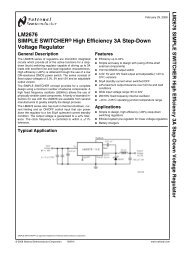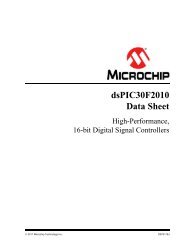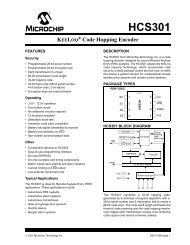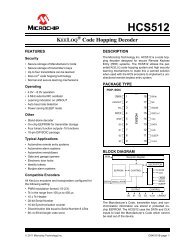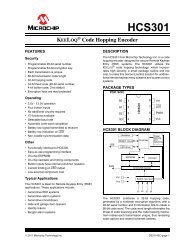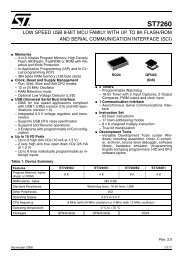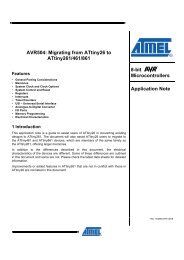Create successful ePaper yourself
Turn your PDF publications into a flip-book with our unique Google optimized e-Paper software.
<strong>STM32W108C8</strong><br />
General-purpose input/outputs<br />
Note:<br />
When configured in output mode:<br />
● The output drivers are enabled and are controlled by the value written to<br />
GPIO_PxOUT:<br />
● In open-drain mode: 0 activates the N-MOS current sink; 1 tri-states the pin.<br />
● In push-pull mode: 0 activates the N-MOS current sink; 1 activates the P-MOS current<br />
source.<br />
● The internal pull-up and pull-down resistors are disabled.<br />
● The Schmitt trigger input is connected to the pin.<br />
● Reading GPIO_PxIN returns the input at the pin.<br />
● Reading GPIO_PxOUT returns the last value written to the register.<br />
Depending on configuration and usage, GPIO_PxOUT and GPIO_PxIN may not have the<br />
same value.<br />
Alternate output mode<br />
In this mode, the output is controlled by an on-chip peripheral instead of GPIO_PxOUT and<br />
may be configured as either push-pull or open-drain. Most peripherals require a particular<br />
output type - I 2 C requires an open-drain driver, for example - but since using a peripheral<br />
does not by itself configure a pin, the GPIO_PxCFGH/L registers must be configured<br />
properly for a peripheral's particular needs. As described in Section 8.1.2: Configuration on<br />
page 56, when more than one peripheral can be the source of output data, registers in<br />
addition to GPIO_PxCFGH/L determine which to use.<br />
Note:<br />
When configured in alternate output mode:<br />
● The output drivers are enabled and are controlled by the output of an on-chip<br />
peripheral:<br />
● In open-drain mode: 0 activates the N-MOS current sink; 1 tri-states the pin.<br />
● In push-pull mode: 0 activates the N-MOS current sink; 1 activates the P-MOS current<br />
source.<br />
● The internal pull-up and pull-down resistors are disabled.<br />
● The Schmitt trigger input is connected to the pin.<br />
● Reading GPIO_PxIN returns the input to the pin.<br />
Depending on configuration and usage, GPIO_PxOUT and GPIO_PxIN may not have the<br />
same value.<br />
Alternate output SPI SCLK mode<br />
SPI master mode SCLK outputs, PB3 (SC1SCLK) or PA2 (SC2SCLK), use a special output<br />
push-pull mode reserved for those signals. Otherwise this mode is identical to alternate<br />
output mode.<br />
8.1.7 Wake monitoring<br />
The GPIO_PxWAKE registers specify which GPIOs are monitored to wake the processor. If<br />
a GPIO's wake enable bit is set in GPIO_PxWAKE, then a change in the logic value of that<br />
GPIO causes the <strong>STM32W108C8</strong> to wake from deep sleep. The logic values of all GPIOs<br />
are captured by hardware upon entering sleep. If any GPIO's logic value changes while in<br />
sleep and that GPIO's GPIO_PxWAKE bit is set, then the <strong>STM32W108C8</strong> will wake from<br />
deep sleep. (There is no mechanism for selecting a specific rising-edge, falling-edge, or<br />
level on a GPIO: any change in logic value triggers a wake event.) Hardware records the fact<br />
Doc ID 018587 Rev 2 60/215





